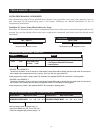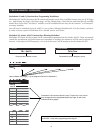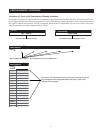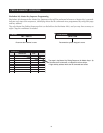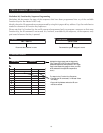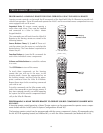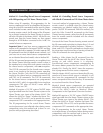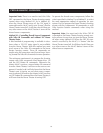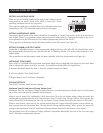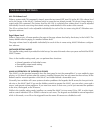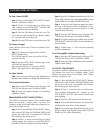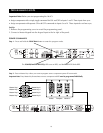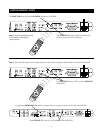
Method #1– Controlling Shared Source Components
with IR Repeating and 12V Home Theater Status
When using IR repeating, IR programming for the
source components can be accomplished by program-
ming the actual IR commands from the source compo-
nent’s included remote control into the Home Theater
learning remote control. An IR output of the IR repeat-
ing or control system for the Home Theater is connect-
ed to the IR input of the Master A4.6Ci. All the IR com-
mands sent from the home theater are then passed
through to all IR flashers connected to the A4.6Ci for
control of source components.
Important Note: If you have source components that
require an IR command to be turned ON/OFF and they
are not provided with a separate ON and a separate OFF
IR command from their included remote controls, or if
you have two or more shared source components that
are an identical brand and model, refer to Method #2.
All the IR command programming accomplished into
the Home Theater learning remote control is done in
the standard way using the actual remote controls for
the shared source components, with one exception.
The OFF IR command for the shared source compo-
nents is not taught to the learning remote operating
the Home Theater. Only the ON IR commands are
taught for the shared source components turned ON
and OFF via IR commands. The OFF IR commands
for the shared source components are programmed
into the A4.6Ci, which is responsible for turning these
components OFF when all A4.6Ci zones and the
Home Theater are OFF.
Method #1 requires a 12V DC system ON/OFF status
signal provided from the Home Theater system to the
Home Theater sync input of the Master A4.6Ci. This
allows the A4.6Ci to “know” whether the Home The-
ater is actually ON or OFF, and to provide the source
components’ OFF commands at the appropriate time.
The IR programming for the actual Home Theater
receiver/processor is not affected when sharing source
components using this method and is done in con-
junction with programming described.
Method #2 – Controlling Shared Source Components
with Niles R-4 Commands and 12V Home Theater Status
A second method of programming a Home Theater
remote control is available when the shared source
components are identical and/or they have a single
power ON/OFF IR command. With this method, you
teach the Niles Control IR commands to the Home
Theater learning remote, rather than the IR commands
from the remote controls included with the shared
source components.
You teach the Home Theater learning remote control
the IR commands equivalent to Master Keys 1-8 and
all other commands (excluding Volume +, Volume –,
Mute, and OFF). These IR commands are taught using
the same steps used for teaching a learning remote the
Niles IR commands for zone operation.
Sending a Niles Master Key IR command from the
Home Theater tells the A4.6Ci the Home Theater is
turning on and which source it is selecting.
Synchronized source components corresponding to
the source button pressed are then turned ON, if not
already ON. Finally, the A4.6Ci issues the sequence
that is programmed for that source component.
After the Master A4.6Ci receives a Master Key IR com-
mand and it knows which source is selected, it will
then issue the programmed IR commands for that
source component when function key IR commands
are received from the Home Theater.
Identical shared source components are operated
individually using this method via the IR routing fea-
ture of the A4.6Ci (refer to Identical Source
Components in the Operational Overview Section).
Method #2 requires a 12V DC system ON/OFF status
signal provided from the Home Theater system to the
Home Theater sync input of the Master A4.6Ci. This
allows the A4.6Ci to “know” whether the Home The-
ater is actually ON or OFF, and to provide the source
components OFF commands at the appropriate time.
The IR programming for the actual Home Theater
receiver/processor is not affected when sharing source
components with this method and is done in con-
junction with programming described.
63
PROGRAMMING OVERVIEW



